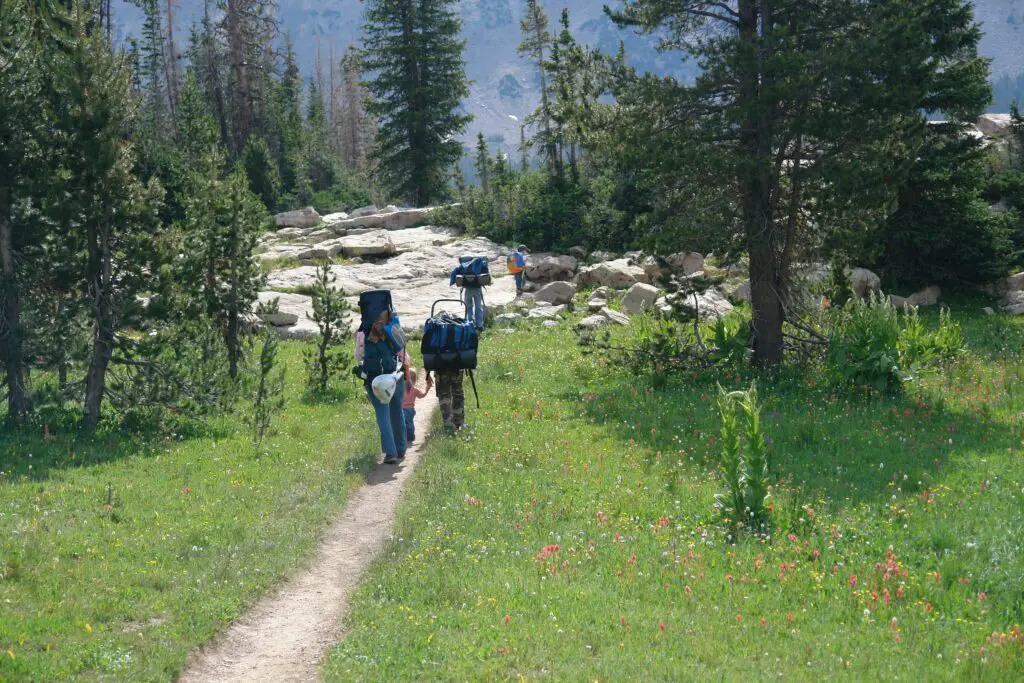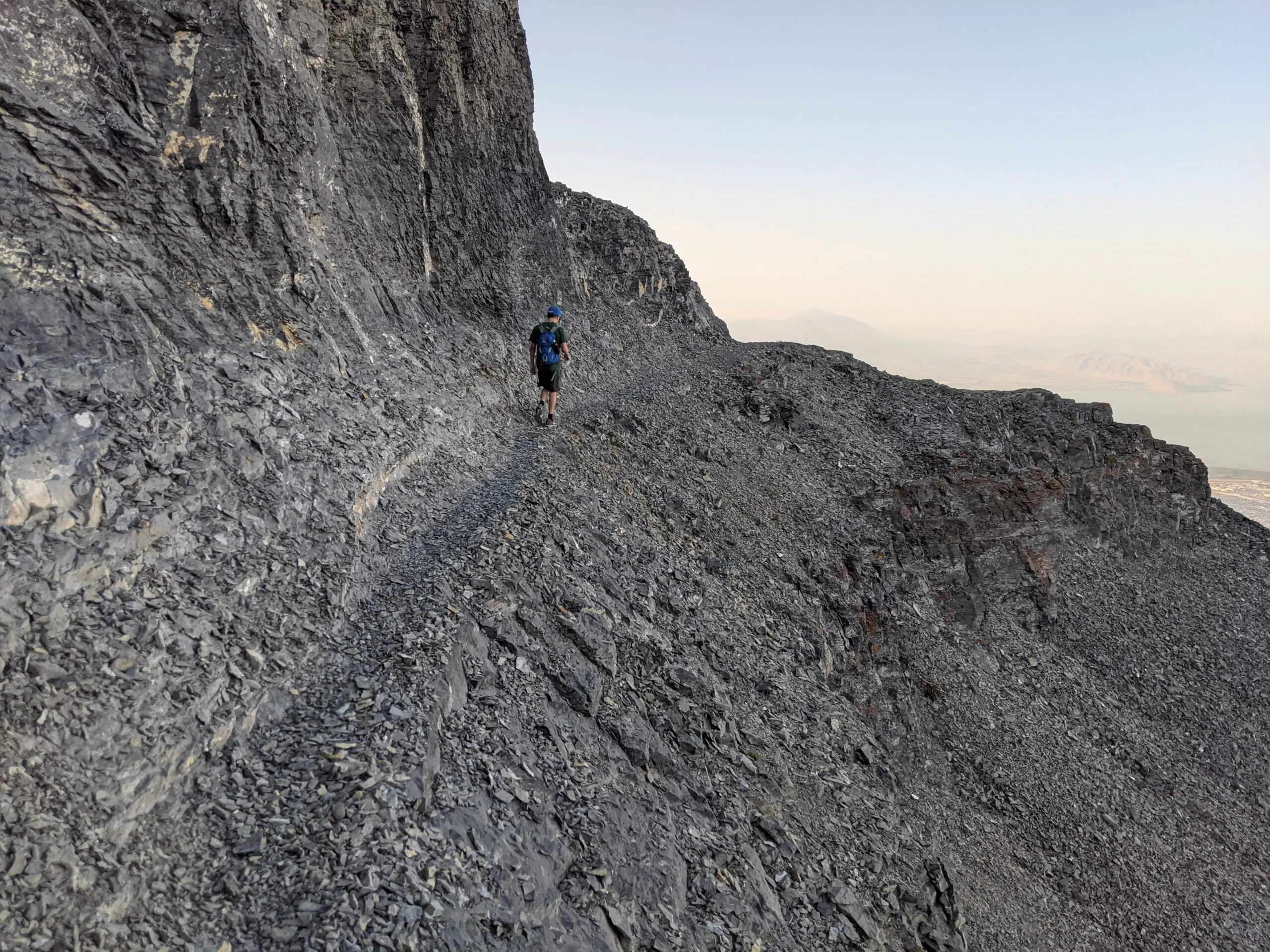The counsel to move more and sit less is an oft repeated wellness tip. The many associated benefits of movement support the validity of this recommendation. In particular, guidelines emphasize the need for adults, teens, and children to include aerobic activity throughout the week.
The phrase Aerobic Exercises is often used interchangeably with Cardio Exercises. This type of activity strengthens the heart or cardiovascular system. Those who prefer to hike over other forms of movement may ask, what type of cardio is hiking?
Hiking is a low impact, moderate intensity cardio activity. The use of oxygen derived energy and an increased heart rate distinguishes hiking as a cardiovascular “cardio” exercise. Many distinct ways to categorize cardio activities exist, but the most common ones include level of intensity and impact. Hiking offers low impact with moderate intensity movements.
These characteristics also categorize hiking as aerobic or “with oxygen”. National guidelines refer to aerobic rather than cardio activity; however, it generally means the same thing.
Continue reading to learn more about hiking, cardio exercise, physical activity recommendations and benefits.
What Makes Hiking a Low Impact, Moderate Intensity Cardio Activity?
Hiking effectively elevates heart rate at a low enough intensity that allows for longer episodes of activity. The low-moderate intensity also makes it an aerobic activity where the oxygen demand can be met through oxygen intake.
Basically, this means that you can hike for long periods of time without stopping to catch your breath, and you can carry on a conversation while doing so. If you really push your pace or tackle some really steep terrain however, the intensity increases.
The ability to meet oxygen needs means the body uses oxygen derived energy, reducing buildup of lactic acid. Lactic acid leads to fatigue and cessation or exercise. The lack of lactic acid build up explains why most cardio or aerobic activities can occur for longer periods of time.
These factors build cardiovascular fitness or cardiovascular respiratory fitness (CRF). The improvement of CRF happens through prolonged aerobic activity and develops a stronger heart, lungs and circulatory system. Exercises that improve CRF are generally referred to as cardio activity.
As a low impact exercise, hiking can protect joints, reduce risk of energy, decrease necessary recovery time and lower the amount of stress the body experiences. These come in addition to all the others benefits associated with cardio activity.
Furthermore, the lower intensity of hiking makes it a perfect choice of movement for adults at all levels of fitness. Different inclines, terrain and environments allow hiking to meet the preferences and needs of just about everybody.
What are Cardio Exercise Categories?
A cardio exercise involves any activity that uses the large muscles in continuous movement and strengthens the heart and lungs. The exercise should allow for conversation as workouts that require too much effort for talking often move to anaerobic activity.
In regard to cardio categories, they can generally be divided per level of intensity and impact.
Intensity
The metabolic equivalent or MET unit is used to determine level of intensity. One MET refers to the amount of energy expended while at rest. This measurement equates to 3.5 milliliters oxygen per kilogram per minute. An activity with a 2.0 MET score will use approximately double the amount of oxygen of a person at rest.
Vigorous intensity- According to the CDC and ACSM guidelines, a vigorous activity will achieve greater than 6.0 METs or consume more than seven calories per minute.
These forms of movement include speed walking (greater than 5mph), running, backpacking, cycling (greater than 10mph), aerobic dancing, rowing, jump rope, martial arts, circuit weight training, many sports, skiing, swimming, pilates, even heavy housework, farming and other arduous occupations
Moderate intensity- A moderate activity achieves 3.0-6.0 METs or consumes three and half to seven calories per minute.
The forms of movement include walking, hiking, leisure rollerblading, leisure cycling, recreational swimming, light dancing, moderate housework, washing a car, some childcare
Follow this link for a more extensive list from the CDC of moderate and vigorous forms of movement. (source )
)
Impact Level
The amount of impact an activity places on the joints will separate high from low impact. High impact activities generally lift both feet off the ground. High intensity exercises often correspond with high impact, but some low impact exercises can be performed at high intensity.
High impact movement includes running, jumping, most sports, high impact dancing, gymnastics, etc.
Low impact- These activities generally keep one foot on the ground and place little strain on joints. These types of activities are especially great for those with chronic injuries, arthritis or other physical activity concerns. They also make great cross-training options.
Elliptical, swimming, walking, hiking, yoga, pilates, rock climbing , mountain biking, cycling, roller blading, low impact dancing, many household chores.
, mountain biking, cycling, roller blading, low impact dancing, many household chores.

Hiking and Trail Running
In a lot of ways, Trail Running is just a high-intensity version of hiking. It’s something I really started to get into when I moved out of the city a few years ago. In some ways it has spoiled hiking for me because when I hike now, I get impatient and just want to go faster!
Trail running is not only more intense, but also higher impact. It is tougher on your joints and can be difficult for people with knee problems and other issues. On the other hand, the higher intensity and higher impact can lead to better results from a physical standpoint.
Benefits of cardiovascular activities like Hiking
All forms of exercise provide physical, mental and emotional health benefits. The following list focuses on benefits experienced through cardiovascular exercise.
- Lower risk of heart disease- Heart health comes through a variety of factors. Physical activity, especially cardiovascular, strengthens the heart by decreasing LDL, increasing HDL, lowering blood pressure and improving blood flow.
- Supports a healthy weight- Movement helps individuals maintain an appropriate energy balance by increasing calorie output. Those who desire to lose weight will find that including more physical activity allows them to reach a desired calorie deficit easier than by diet alone.
- Improved immune system- Studies demonstrate a change in immunoglobulins, gut microbiota and other components supportive of a healthy immune system with regular exercise. However, overtraining without proper rest can result in a less robust immune system.
- Better sleep- Adults need 7-9 hours of sleep in order to perform well. Poor sleep will result in a host of other negative consequences such as increased risk of disease, higher inflammation, poor decision making and fatigue among others. Researchers found that sleep quality and duration improve with regular exercise.
- Boosts mental health- Physical activity can help those who suffer from anxiety, ADHD, OCD, PTSD and depression. It also releases those feel good hormones and neurotransmitters such as dopamine, endorphins and endocannabinoids.
- Improves insulin sensitivity and helps control blood sugar- The blood sugar regulating properties of exercise make consistent physical activity particularly beneficial as we see a rise in diabetes incidence.
- Reduced risk of falls- Cardio will strengthen muscle, bone and grip strength to prevent injury. Daily movement also increases agility and stability. Older adults can benefit greatly from incorporating safe exercise into their routines.
- Improves mental clarity- Researchers find that physical activity can preserve brain mass, increase mental clarity and improve memory creation and learning.
- Heightens quality of life- Along with all the aforementioned benefits, daily movement reduces inflammation and stress. It can also boost self-confidence. Ultimately, study results consistently back the conclusion that exercise remains a crucial component of a happier, healthier and longer life.
Physical Activity Recommendations for Adults
Current recommendations from the CDC encourage adults to incorporate 150 minutes moderate or 75 minutes vigorous activity each week. This guideline breaks down to about thirty minutes of moderate activity for five days of the week. They also suggest adding in at least two muscle strengthening sessions per week.
The guidelines push adults towards moving more and sitting less. They also emphasize finding time for stretching or other activities that increase flexibility. Experts counsel adults to perform even more than the 150-minute recommendations for additional health benefits or for those hoping to lose weight.

Quick Hiking Nutrition Tips
As I’ve written previously , it’s really important to fuel your body while hiking. People get into trouble in the backcountry when they fail to properly fuel and hydrate. At the same time, some of the weight loss benefits of hiking can easily be negated if you consume too many calorie-dense hiking snacks at the same time.
, it’s really important to fuel your body while hiking. People get into trouble in the backcountry when they fail to properly fuel and hydrate. At the same time, some of the weight loss benefits of hiking can easily be negated if you consume too many calorie-dense hiking snacks at the same time.
Pre-hike Nutrition
Snacks and meals in the hours before hiking or any other cardio activity should contain mostly carbohydrate with some protein and little fat. The carbohydrates provide energy and protein adds satiety and provides the building blocks for body maintenance and repair.
Fats play an important role in health, but may cause gut distress when eaten close to work outs. Foods high in fiber, personal dietary irritants and sugar alcohols may also cause unpleasant symptoms. High sugar content contributes to blood sugar spikes and crashes leading to early fatigue.
Example of pre-hike meal: Egg on toast with fruit
Nutrition During the Hike
Short hikes often do not require nutrition. However, hikes lasting longer than an hour may necessitate a snack. These snacks should avoid the aforementioned high fat, fiber and sugar alcohol foods. The purpose of food during exercise is to refuel and should emphasize carbohydrates.
Example of snack during hike: Crackers with peanut butter
Post-Hike Nutrition
The body needs adequate nutrients for effective recovery. Try to consume carbohydrates and protein within a couple of hours of a workout. Individuals should consume nutrient dense foods throughout the rest of the day with a balance of carbohydrate, protein and fats.
Example of meal after hike: Salmon and rice with roasted vegetables
Hydration During Hiking
Try to be properly hydrated before any physical activity. Adequate hydration supports peak performance and prevents negative health consequences of dehydrations. The Academy of Nutrition and Dietetics suggest drinking 4 cups before a hike and 2 cups for every hour spent hiking. After physical activity, experts suggest replacing every pound of weight lost with 16-24 ounces of water
Summary
Hiking is a low impact, moderate intensity cardio or aerobic activity that is great for physical, mental, and emotional health. As a moderate intensity activity, it’s something best done with other people for safety reasons, as well as social reasons.
The benefits of cardiovascular-boosting activities like hiking are myriad, and it’s important to get enough activity and exercise each week to live a complete life. Hiking is a great way to do that.
Related Questions
Is Hiking the Best Cardio? Hiking can be a better cardio activity than walking, but usually isn’t as strenuous or intense as running or trail running. Cardio activities should be varied, and hiking fits well into a balanced exercise plan.
What Kind of Exercise is Hiking? Hiking is a moderate intensity aerobic or cardio activity that varies in difficulty based on the terrain and the hiker’s speed. Hiking is a good exercise for legs, especially when going through hilly or mountainous terrain.
Is Hiking Better than Working Out? Hiking can be a good aerobic or cardio activity, but it does not replace the need for strength training or working out. Adults should participate in muscular strength training exercises at least twice per week in addition to cardio.

